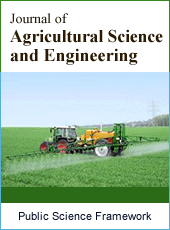Journal of Agricultural Science and Engineering
Articles Information
Journal of Agricultural Science and Engineering, Vol.2, No.4, Aug. 2016, Pub. Date: Aug. 19, 2016
Early Growth Performance and Reforestation Potential of Acacia polyacantha on Two Different Soil Types: The Case of Jaji Village in Chiweshe, Zimbabwe
Pages: 31-35 Views: 5274 Downloads: 1120
[01]
Nyamugure Tendayi, Department of Environmental Science, Faculty of Agriculture and Environmental Science, Bindura University of Science Education, Bindura, Zimbabwe.
[02]
Mudyiwa Silas Mufambi, Department of Environmental Science, Faculty of Agriculture and Environmental Science, Bindura University of Science Education, Bindura, Zimbabwe.
[03]
Sabunet Charles, Department of Environmental Science, Faculty of Agriculture and Environmental Science, Bindura University of Science Education, Bindura, Zimbabwe.
[04]
Chikorowondo Gift, Department of Environmental Science, Faculty of Agriculture and Environmental Science, Bindura University of Science Education, Bindura, Zimbabwe.
[05]
Mukumbe Peter, Department of Environmental Science, Faculty of Agriculture and Environmental Science, Bindura University of Science Education, Bindura, Zimbabwe.
[06]
Makuku Tapiwa, Department of Environmental Science, Faculty of Agriculture and Environmental Science, Bindura University of Science Education, Bindura, Zimbabwe.
There has been massive deforestation in Chiweshe communal lands which has led to aridness of the area. Mazowe Rural District Council wants to engage Chiweshe community in a reforestation program different from the past programs as it includes indigenous tree species. Acacia polyacantha was chosen as the indigenous species to be used and its performance in Chiweshe soils is not known hence the need for this study. The study aimed at assessing the early growth performance of Acacia polyacantha on two sites of Jaji village in Chiweshe, one with sand and the other with loam soils. A completely randomised design was used on each site. Initial height and root collar of the plants was measured on the planting day. The subsequent root collar diameter, height and survival rate of the plants in the two sites were monitored after every three months. The study showed that in terms of height and root collar diameter, A. polyacantha performed better in loam than in sand soils. There was no significant difference in the survival rate of the species in the two sites. Therefore, the study recommends the possibility of using A. polyacantha on either soil type for reforestation purposes.
Degradation, Chiweshe, Indigenous Species, Acacia polyacantha
[01]
ADEH: Australian Department of the Environment and Heritage, (2003). Mosquite (Prosopis species) weeds of national significance: Weed Management Guide, Department of the Environment and Heritage and the CRC for Australian Weed Management.
[02]
Chazdon, R. L., (2014) Second Growth: The promise of tropical forest regeneration in an age of deforestation. University of Chicago Press.
[03]
Corlett, R. T., (1999) Environmental forestry in Hong Kong: 1871-1997. Forest ecology and Management 116:93-105.
[04]
Doronila, A. I. and Fox, J. E. D., (2000) Ecosystem development on a titanium dioxide residue pond after five years in Capel, Western Australia. International Journal of Surface Mining, Reclamation and Environment 14: 137-150.
[05]
FAO (2010) Global forestry resources assessment. FAO, Rome.
[06]
Hamad, A. A. and Kamal, F. E. (2006) One-year field performance of some Acacia and Prosopis Species in Saudi Arabia. Asia J. Plant Sci. 5(5): 763-766.
[07]
He, A., Bleby, T. M., Veneklaas, E. J. and Lambers, H. (2011) Dinitrogen-fixing Acacia species from phosphorus-impoverished soils resorb leaf phosphorus efficiently. Plant, Cell and Environment 34: 2060–2070.
[08]
Kamara, C. S. and Maghembe, J. A. (1994) Performance of multipurpose tree and shrub species 28 months after planting at Chilimbana, Zambia. For. Ecol. And Manag 64: 145-151.
[09]
Myers, N. (1993). Tropical forest: the main deforestation fronts. Environ. Conserv, 20: 9-16.
[10]
Nyakudya, I. W., Jimu, L., Katsvanga, CAT., Dafana, M. (2011) Comparative analysis of the early growth performance of indigenous Acacia species in revegetating Trojan Nickel Mine tailings in Zimbabwe. African Journal of Environmental Science and Technology Vol. 5(3): 218-227.
[11]
van Breugel, M., Hall, J. S., Craven, D. J., Gregoire T. G, Park, A., Dent, D. H., Wishnie, M. H., Mariscal, E., Deago, J., Ibarra, D., Cedeno N. and Ashton, M. N. (2011) Early growth and survival of 49 tropical tree species across sites differing in soil fertility and rainfall in Panama. Forest Ecology and Management 261: 1580–1589.
[12]
Wade, M. R., Gurr, G. M. and Wratten, S. D., (2008). Ecological restoration of farmland: progress and prospects. Philosophical Transactions of the Royal Society B: Biological Sciences 363: 831-847.
[13]
Witkowski, E. T. F. (1991) Effects of invasive alien Acacias on nutrient cycling in the coastal lowlands of the Cape fynbos. Journal of Applied Ecology, 28: 1-15.
[14]
Yates, C. J. and Hobbs, R. H., (1997). Temperate eucalypt woodlands: a review of their status, processes threatening their persistence and techniques for restoration. Australian Journal of Botany 45(6): 949-973.
[15]
Zahawi, R. A., Eckert, C., Chaves-Fallas, J. M., Schwanitz, L., Rosales, J. A. and Holl, K. D. (2015). The effect of restoration treatment soils and parent tree on tropical forest tree seedling growth. Open Journal of Forestry 5: 154-161.

ISSN Print: 2381-6821
ISSN Online: 2381-6848
Current Issue:
Vol. 7, Issue 4, December Submit a Manuscript Join Editorial Board Join Reviewer Team
ISSN Online: 2381-6848
Current Issue:
Vol. 7, Issue 4, December Submit a Manuscript Join Editorial Board Join Reviewer Team
| About This Journal |
| All Issues |
| Open Access |
| Indexing |
| Payment Information |
| Author Guidelines |
| Review Process |
| Publication Ethics |
| Editorial Board |
| Peer Reviewers |


